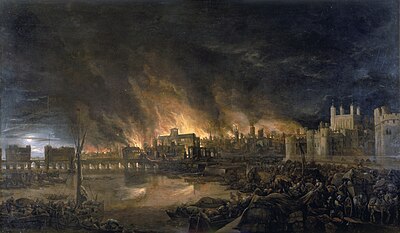Our website is made possible by displaying online advertisements to our visitors.
Please consider supporting us by disabling your ad blocker.
Great Fire of London


The Great Fire of London was a major conflagration that swept through central London from Sunday 2 September to Thursday 6 September 1666,[b] gutting the medieval City of London inside the old Roman city wall, while also extending past the wall to the west. The death toll is generally thought to have been relatively small,[1][2] although some historians have challenged this belief.[3]
The fire started in a bakery in Pudding Lane shortly after midnight on Sunday 2 September, and spread rapidly. The use of the major firefighting technique of the time, the creation of firebreaks by means of removing structures in the fire's path, was critically delayed due to the indecisiveness of the Lord Mayor, Sir Thomas Bloodworth. By the time large-scale demolitions were ordered on Sunday night, the wind had already fanned the bakery fire into a firestorm which defeated such measures. The fire pushed north on Monday into the heart of the City. Order in the streets broke down as rumours arose of suspicious foreigners setting fires. The fears of the homeless focused on the French and Dutch, England's enemies in the ongoing Second Anglo-Dutch War; these substantial immigrant groups became victims of street violence. On Tuesday, the fire spread over nearly the whole city, destroying St Paul's Cathedral and leaping the River Fleet to threaten Charles II's court at Whitehall Palace. Coordinated firefighting efforts were simultaneously getting underway. The battle to put out the fire is considered to have been won by two key factors: the strong east wind dropped, and the Tower of London garrison used gunpowder to create effective firebreaks, halting further spread eastward.
The social and economic problems created by the disaster were overwhelming. Flight from London and settlement elsewhere were strongly encouraged by Charles II, who feared a London rebellion amongst the dispossessed refugees. Various schemes for rebuilding the city were proposed, some of them very radical. After the fire, London was reconstructed on essentially the same medieval street plan, which still exists today.[4]
Cite error: There are <ref group=lower-alpha> tags or {{efn}} templates on this page, but the references will not show without a {{reflist|group=lower-alpha}} template or {{notelist}} template (see the help page).
- ^ Cite error: The named reference
tindeathwas invoked but never defined (see the help page). - ^ Cite error: The named reference
porterdeathwas invoked but never defined (see the help page). - ^ Cite error: The named reference
Hanson 2001, 326–33was invoked but never defined (see the help page). - ^ Reddaway, 27
Previous Page Next Page


